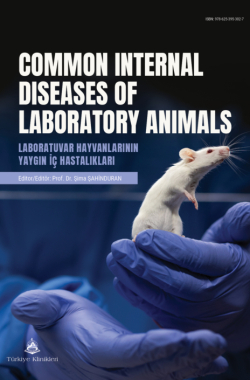Pasteurellosis in Laboratory Animals
Merve İDERa , Amir NASERİa
aSelçuk University Faculty of Veterinary Medicine, Department of Internal Medicine, Konya, Türkiye
İder M, Naseri A. Pasteurellosis in laboratory animals. In: Şahinduran Ş, ed. Common Internal Diseases of Laboratory Animals. 1st ed. Ankara: Türkiye Klinikleri; 2024. p.66-9.
ABSTRACT
Pasteurellosis in laboratory animals is a common bacterial infection caused by serotypes of Pasteurella multocida. The most susceptible laboratory animals to Pasteurella multocida are rabbits and mice, and clinical signs usually include upper respiratory tract infection, rhinitis, sinusitis, and conjunctivitis. In experimental studies, results may be adversely affected by the presence of Pasteurellosis. This chapter attempts to address the pathogenesis, clinical findings, diagnosis, and treatment of pasterullosis in laboratory animals.
Keywords: Pasteurellosis; respiratory infection; laboratory animals
Kaynak Göster
Referanslar
- Nagarajan P, Gudde R, Srinivasan R, Veterinary OTN. Essentials of laboratory animal science: Principles and Practices, Springer; 2021. [Crossref]
- Mamak N. The most important infectious illnesses of rabbits. J Poultry Res (Turkey). 1999;1:55-9.
- Christensen H, Bisgaard M, Angen O, Frederiksen W, Olsen JE. Characterization of sucrose-negative Pasteurella multocida variants, including isolates from large-cat bite wounds. J Clin Microbiol. 2005;43(1):259-70. [Crossref] [PubMed] [PMC]
- Christensen H, Bisgaard M. The Genus Pasteurella. In: Dworkin M, Falkow S, Rosenberg E, Schleifer KH, Stackebrandt E, eds. The Prokaryotes. New York, NY.: Springer; 2006. [Crossref]
- Aydin N. Pasteurella, Mannheimia, Haemophilus ve Actinobacillus İnfeksiyonları. In: Aydin N, Paraciklioglu J, editörler. Veteriner Mikrobiyoloji (Bakteriyel Hastalıklar) Ankara: İlke Emek Yayınları; 2006. p.171-93.
- Harper M, Boyce JD, Adler B. Pasteurella multocida pathogenesis: 125 years after Pasteur. FEMS Microbiol Lett. 2006;265(1):1-10. [Crossref] [PubMed]
- Dziva F, Muhairwa AP, Bisgaard M, Christensen H. Diagnostic and typing options for investigating diseases associated with Pasteurella multocida. Vet Microbiol. 2008 Apr 1;128(1-2):1-22. [Crossref] [PubMed]
- Jaglic Z, Kucerova Z, Nedbalcova K, Kulich P, Alexa P. Characterisation of Pasteurella multocida isolated from rabbits in Czech Rebuplic. Vet Med-Czech. 2006;51:278-87. [Crossref] [PubMed] [PMC]
- Alçığır, ME, Atalay Vural S, Müştak K, Tunç AS. Naturally infection with Pasteurella multocida in a rabbit: the pathological and microbiological findings Ankara Univ Vet Fak Derg. 2014;61(2):147-50. [Crossref]
- Percy DH, Barthold SW Rabbit. Pathology of Labaratory Rodents and Rabbits. 3rd ed. Blackwell publishing; 2007. p.264-7. [Crossref]
- DiGiacomo RF, Xu YM, Allen V, Hinton MH, Pearson GR. Naturally acquired Pasteurella multocida infection in rabbits: clinicopathological aspects. Can J Vet Res. 1991;55(3):234-8.
- Bilgili A, Gürel Y. Treatment of Diseases of Laboratory Animals. Etlik J Veterinary Microbiol. 2002;13(1):77-88.
- Percy DH, Barthold SW. Pathology of laboratory rodents and rabbits. John Wiley & Sons, New York; 2013.
- Townsend KM, Frost AJ, Lee CW, Papadimitriou JM, Dawkins HJ. Development of PCR assays for species- and type-specific identification of Pasteurella multocida isolates. J Clin Microbiol. 1998;36(4):1096-100. [Crossref] [PubMed] [PMC]
- Yarım M. Pathologic findings in experimental pasteurellosis in rabbits. Ankara Univ Vet Fak Derg. 2011;58(1):21-6. [Crossref]
- Brennan PC, Fritz TE, Flynn RJ. Role of Pasteurella pneumotropica and Mycoplasma pulmonis in murine pneumonia. J Bacteriol. 1969;97(1):337-49. [Crossref] [PubMed] [PMC]
- Williford CL, Boivin GP. Pasteurella pneumotropica, p 145. In: Manual of microbiologic monitoring of laboratory animals. 2nd ed. Bethesda (MD): National Institutes of Health; 1994.
- Towne JW, Wagner AM, Griffin KJ, Buntzman AS, Frelinger JA, Besselsen DG. Elimination of Pasteurella pneumotropica from a mouse barrier facility by using a modified enrofloxacin treatment regimen. J Am Assoc Lab Anim Sci. 2014;53(5):517-22.
- Matsumiya LC, Lavoie C. An outbreak of Pasteurella pneumotropica in genetically modified mice: treatment and elimination. Contemp Top Lab Anim Sci. 2003;42(2):26-8.
- Scharmann W, Heller A. Survival and transmissibility of Pasteurella pneumotropica. Lab Anim. 2001;35(2):163-6. [Crossref] [PubMed]
- Ouellet M, Cowan M, Laporte A, Faubert S, Héon H. Implementation of a PCR assay of Pasteurella pneumotropica to accurately screen for contaminated laboratory mice. Lab Anim (NY). 2011;40(10):305-12. [Crossref] [PubMed]
- Patten CC Jr, Myles MH, Franklin CL, Livingston RS. Perturbations in cytokine gene expression after inoculation of C57BL/6 mice with Pasteurella pneumotropica. Comp Med. 2010;60(1):18-24.

